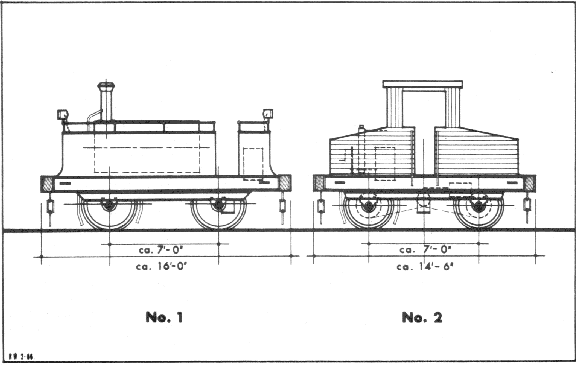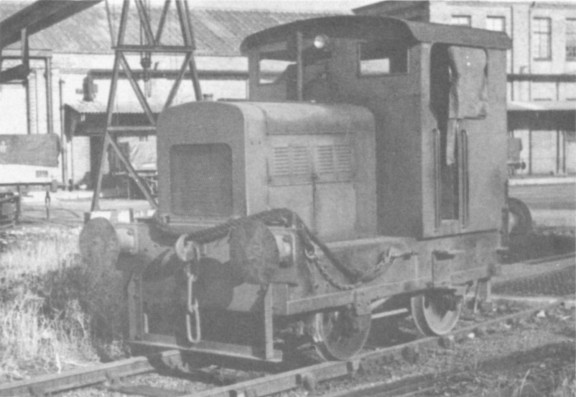
| THE INDUSTRIAL RAILWAY RECORD |
© SEPTEMBER 1967 |
R. & A. MAIN LTD., EDMONTON
H. W. PAAR
The locomotive history of R. & A. Main Ltd., Edmonton, London.N.18 (makers of gas equipment) has two strange features. Horse traction was superceded, not by steam, but by an internal combustion locomotive; and this form of motive power alone was used for more than half a century. The factory was served by a modest siding just south of Angel Road station, on the Liverpool Street to Cambridge line of the former Great Eastern Railway.
The first locomotive dated from about 1909 at least, possibly earlier (the firm moved from Clerkenwell to Edmonton in 1900, but a horse was used to shunt the siding originally). The motive power was provided by a 10 h.p. two-cylinder petrol engine made in the works, the prototype being a Daimler lorry engine. Side valves were used, and a low-tension magneto provided the ignition. the cylinder heads having wiping contacts and not the sparking plugs associated with high-tension ignition. Two cast gun-metal gear-wheels drove a small pinion, to provide the cylinder timing. The power drive passed via a gearbox to one axle, which carried a large coarse-tooth gear wheel made in two halves and bolted on. When the throttle was closed the gear ratio was sufficient to check the speed of the locomotive; the only brake was a screw-on hand brake. The main frame was of channel section about 12in deep, mounted on four large wheels, the axles being carried in plummer blocks or the undersides of the channels. The starting handle was loose and it was positioned at a very awkward height; I am told that one could see the end of the crank going round with the pin for engaging the starting handle.


The last of the
four locomotives, Ruston Hornsby 237918
in November 1957.
(Major E.A.S. Cotton)
A cylindrical tank resembling a boiler carried a chimney (up which the exhaust passed), and this led to a belief (probably quite erroneous) that a steam engine had been originally envisaged. The tank contained water which served to increase the adhesive weight of the locomotive and to cool the engine. The illusion of a steam locomotive was removed by a high apron-plate which ran round the frame, surmounted by a hand-rail and with a gap for across to the footplate. At each corner was fitted a pair of 1½in steel hooks; when wagons needed to be fly-shunted the towing rope was attached to the appropriate hook. Fittings included powerful acetylene car-type lamps with "Mangin" lenses at each end, baulks of timber to serve as buffers, and sanding pipes to the leading wheels. There was room between the water tank and apron for the driver to walk round, coupling and uncoupling being performed without leaving the machine. About the only items bought outside the works were the magneto, wheels and axles; the gun-metal gears were not covered, and in action they "used to ring like a bell".
In about 1924 a replacement locomotive was needed, and the accumulation of redundant materials being propitious, the petrol-electric type was adopted. Before the First World War, the firm had purchased a number of omnibus chassis with Wolseley engines from the Union Jack concern, squeezed out of business by the London General Omnibus Company. These had been converted to lorries but, after the War, replacement Dorman engines were fitted. By the time the second locomotive was conceived, one of these Dorman engines was on hand, plus a spare Wolseley back-axle fitted for chain drive, and a 100
−amp 100−volt Crompton dynamo dating from 1899. The missing link, a traction motor, was provided new by Crompton & Co. Ltd.; this drove the back-axle, which in turn drove the two running axles by separate chains. No photograph of this locomotive is known, but it had a cab raised above the bodywork in a central position. The body, constructed in the main with tongued and grooved wooden boards, was painted battleship grey, the frame and wheels being black. The driver was able to walk along a gangway, probably on one side of the engine only. The towing hooks were similar to those on the first locomotive, and again only a handbrake was fitted.This second unit served adequately for about a decade, although the little dynamo was severely taxed when three or four loaded trucks were being taken round some of the curves, especially as the track was in rather poor shape at that time. So, in 1933, the first professionally-made locomotive was purchased, a four-wheeled petrol-electric machine built by the Drewry Car Co. Ltd., works number 2075. This was a typical product of that firm, and again the two axles were chain-driven. A high, ungainly, cab was the main feature, with an access door facing the front on one side. This locomotive, painted a dull brick red, was still being retained as a stand-by in 1957, having been superceded in 1945 by a small four-wheeled Ruston & Hornsby diesel shunter, (works number 237918), again a typical product of its makers, painted dark green. In November 1965 both were still on the premises, but out of use as rail traffic had ceased.
As far as is known, the horse was the only one of Main's power units to have a name "BOB". The first two locomotives were designed and built by Thomas Glover & Co. Ltd., a firm which had amalgamated with R. & A. Main Ltd. to form Glover & Main Ltd., although both had kept separate identities. The Drewry and the Ruston were purchased new by R. & A. Main Ltd.
I am indebted to Mr F. Munday, the former works engineer, for much of the information in this article, and to Roger West for preparing the drawings from Mr Munday's sketches.
"STOCKSBRIDGE RAILWAY. On Tuesday afternoon, a large and very powerful new locomotive made its first trip on the Stocksbridge Railway, which is now nearly completed. The engine is called "WHARNCLIFFE", and weighs about 25 tons." ("Iron", Friday, 21st July 1877.) (K.P.P.)
* * *
Another accident took place in October 1889. Two trains, one loaded with granite and the other with bricks, came into collision at the Morris Brook Grove curve through gross carelessness; they were both going at a good speed; the drivers of the GARSTON and SALFORD, when they saw the smash inevitable, both jumped off into a cutting 35ft deep. There was considerable wreckage of both engines and waggons, the damage being about £150. ("History of the Manchester Ship Canal", Vol 2, 1907. SALFORD would appear to be Manning Wardle 1024 of 1888 an 0−6−0 saddle tank but we cannot trace GARSTON. Can any reader help?)